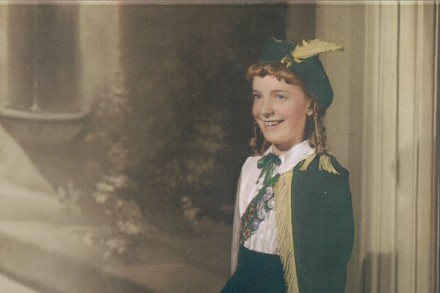Interviewer: Ben Stephenson for National Library of Australia
Irish dancing has been at the centre of Sydney-born Maureen Whelan’s professional life for more than 50 years. But for one of the founders of Sydney’s renowned Dwyer-Whelan Academy of Irish Dance, it’s perhaps pure chance it all turned out that way. In the early 1950s her mother, May Dwyer, got a secretarial job with the St George Eisteddfod organisation, a situation that was to change Maureen’s life. One night her father, Bill Dwyer, a New Zealander of Irish extraction, walked in on four boys practicing Irish dancing for the Eisteddfod. Maureen recalls what he said when he came home:
‘I’ve just seen these four dancers, they were so good, that’s what Maureen’s going to do, Irish dancing’.
Soon Maureen, aged 9, was taking lessons from Erin O’Daly, one of the top Sydney teachers of Irish dancing of her day, loving it all and gradually realising she was good at something. And from there Maureen’s memories cover the world of Irish dancing in Sydney and Australia since the early 1950s, from performing on rickety platforms for the St Patrick’s Day celebrations at the Sydney Sports Ground, to the sophisticated, high powered, international style of dancing taught today in Irish dancing schools across the country.
For students of Irish dancing, Maureen has a lot to say about the significant changes in styles since the 1950s. That was an era when the older forms, brought from Ireland itself in the late 19th century, prevailed, dances such as the Humours of Bandon, the Blackbird and various jigs and reels. Indeed for anyone trying to understand the complex evolution of Irish dancing, both in Australia and overseas in the last half century, what Maureen Whelan has to say is essential listening.
Of all Maureen’s recollections one of the most vivid is of Irish dancing at the St Patrick’s Days of old. In the 1950s the event was still under the control of the Catholic church and everything focused on dance performances, Gaelic games and athletics at the Sydney Sports Ground. For the occasion Maureen’s mother provided her with a green pleated skirt, white satin blouse, green bow, velvet shawl, knitted knee length stockings with yellow turn-downs, and a velvet hat with a feather. A far cry from today’s elaborate hairstyles and bright sequined dresses! With others she danced to fiddlers and piano accordionists, playing without amplification, on small wooden dancing stages as the sun beat down and the surface became slippery. If the rain came down, the dancers sheltered under the platform. Maureen remembers the whole show as a bit chaotic, for as they danced starter guns would be going off for the athletics and cheers would go up for from those watching Gaelic football matches – all at the same time. It was great fun and the dancing highly competitive, a situation from which Maureen herself took home many a trophy.
It was Irish dancing, and the Irish social scene that brought Maureen Whelan to dance nights at the INA. There she met and eventually married Kilkenny man Phil Whelan, a £10 passage immigrant, and a hurler. Today she still takes a class at the INA and sums up her life devoted to Irish dancing and teaching Irish dancing in these words:
I ended up at a Catholic School, I did Irish dancing, I became a teacher, an adjudicator, an examiner and I married an Irishman, isn’t that incredible.

